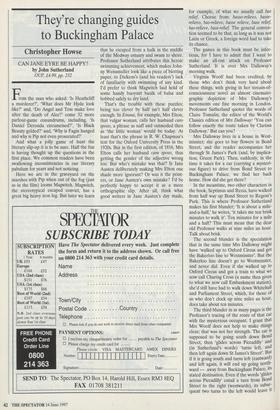They're changing guides to Buckingham Palace
Christopher Howse
CAN JANE EYRE BE HAPPY? by John Sutherland OUP, £4.99, pp. 232 From the man who asked: `Is Heathcliff a murderer?', 'What does Mr Hyde look like?' and, 'Do Angel and Tess make love after the death of Alec?' come 32 more parlour-game conundrums, including, 'Is Daniel Deronda circumcised?', 'Is Black Beauty gelded?' and, `Why is Fagin hanged and why is Pip not even prosecuted?'
And what a jolly game of hunt the literary slip-up it is to be sure. Half the fun is having thought up the questions in the first place. We common readers have been swallowing inconsistencies in our literary pabulum for years and not noticing.
Here we are in the graveyard on the marshes with Pip when out of the fog (just as in the film) looms Magwitch. Magwitch, the stereotypical escaped convict, has a great big heavy iron leg. But later we learn that he escaped from a hulk in the middle of the Medway estuary and swam to shore. Professor Sutherland attributes this heroic swimming achievement, which makes John- ny Weissmuller look like a piece of blotting paper, to Dickens's (and his readers') lack of familiarity with swimming of any kind. I'd prefer to think Magwitch laid hold of some handy buoyant baulk of balsa and bobbed safely to dry land.
That's the trouble with these puzzles; being too clever by half isn't half clever enough. In Emma, for example, Mrs Elton, that vulgar woman, calls her husband caro sposo, a phrase as naff and outmoded then as 'the little woman' would be today. At least that's the phrase in R. W. Chapman's text for the Oxford University Press in the 1920s. But in the first edition, of 1816, Mrs Elton calls her husband cara sposo, thus getting the gender of the adjective wrong too. But who's mistake was that? Is Jane Austen deliberately making Mrs Elton one shade more ignorant? Or was it the print- ers, or Jane Austen's own mistake? I'd be perfectly happy to accept it as a mere orthographic slip. After all, think what good writers in Jane Austen's day made, for example, of what we usually call bas relief. Choose from: basso-relievo, basse- relievo, bas-relievo, basse relieve, base relief bas-relieve, bass-relief The general conven- tion seemed to be that, as long as it was not Latin or Greek, a foreign word had to take its chance.
The games in this book must be infec- tious, for I have to admit that I want to make an all-out attack on Professor Sutherland. It is over Mrs Dalloway's morning walk.
Virginia Woolf had been credited, by those who don't think very hard about these things, with giving in her stream-of- consciousness novel an almost cinemato- graphic depiction of Mrs Dalloway's movements one fine morning in London. Professor Sutherland quotes the words of Claire Tomalin, the editor of the World's Classics edition of Mrs Dalloway: 'You can follow exactly the route taken by Clarissa Dalloway.' But can you?
Mrs Dalloway lives in a house in West- minster; she goes to buy flowers in Bond Street, and the reader accompanies her through St James's Park (and, by implica- tion, Green Park). Then, suddenly, in the time it takes for a car (carrying a mysteri- ous figure) to drive from Bond Street to Buckingham Palace, we find her back home. How did she get there?
In the meantime, two other characters in the book, Septimus and Rezia, have walked from half way up Bond Street to Regent's Park. This is where Professor Sutherland makes his first blunder; 'It is about a mile- and-a-half,' he writes, 'it takes me ten brisk minutes to walk it'. Ten minutes for a mile and a half? This must mean that the dear old Professor walks at nine miles an hour. Talk about brisk.
The second blunder is the speculation that in the same time Mrs Dalloway might have 'walked up to Oxford Circus and got the Bakerloo line to Westminster'. But the Bakerloo line doesn't go to Westminster, and never did. Even if she walked up to Oxford Circus and got a train to what we now call Charing Cross (a name then given to what we now call Embankment station), she'd still have had to walk down Whitehall and Parliament Street, which, for those of us who don't clock up nine miles an hour, does take about ten minutes.
The third blunder in as many pages is the Professor's tracing of the route of that car with the mysterious occupant. I grant that Mrs Woolf does not help to make things clear; that was not her strength. The car is supposed to be going south down Bond Street, then 'glides across Piccadilly' and (in Sutherland's words) 'turns left, and then left again down St James's Street'. But if it is going south and turns left (eastward) and left again, it will end up going north- ward — away from Buckingham Palace, its stated destination. Even if the words 'glides across Piccadilly' entail a turn from Bond Street to the right (westwards), its subse- quent two turns to the left would leave it heading east, again in a contrary direction to Buckingham Palace.
Compared with this peripatetic cat's-cradle, the answer to another puzzle in the book, 'Why the "Single Print of a Foot"?' in Robinson Crusoe is, in Professor Sutherland's favourite word (derived from an obsolete Piedmontese coin), picayune.











































































 Previous page
Previous page